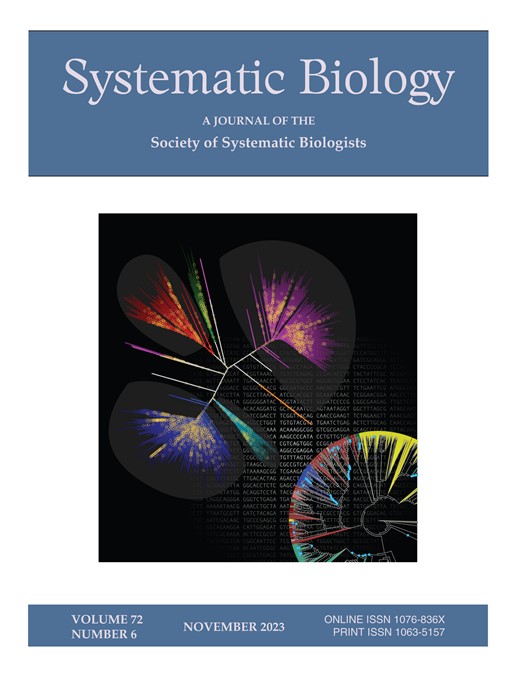Phylogenetic Estimation of Branch-specific Shifts in the Tempo of Origination
IF 5.7
1区 生物学
Q1 EVOLUTIONARY BIOLOGY
引用次数: 0
Abstract
Studying rates of species diversification is one of the key themes in macroevolution. In particular, we are interested in if some clades in a phylogeny diversify more rapidly/slowly than others due to branch-specific diversification rates. A common approach in neontological studies is to use a phylogenetic birth-death process to model species diversification. Specifically, the birth-death-shift process is used to model branch-specific shifts in the tempo of diversification. Here, we present Pesto, a new method and software that estimates branch-specific diversification rates using an empirical Bayes approach. Pesto does not rely on Markov chain Monte Carlo simulations and instead deterministically computes the posterior mean branch-specific diversification rates using only two traversals of the tree. This method is blazingly fast: the birth-death-shift model can be fitted to large phylogenies (>20k taxa) in minutes on a personal computer while also providing branch-specific inference of diversification rate shift events. Thus, we can robustly infer branch-specific diversification rates and the number of diversification rate shift events for large-scale phylogenies, as well as exploring the characteristics of the birth-death-shift model through complex and large-scale simulations. Here, we first describe the method and the software implementation Pesto and explore its behavior using trees simulated under the birth-death-shift model. Then, we explore the behavior of inferring significant branch-specific diversification rate shifts using both Bayes factors and effect sizes. We find few to no false positive inferences of diversification rate shift events but many false negatives (reduced power). The most difficult parameter to estimate is the rate at which diversification rate shifts occur. Despite this, branch-specific diversification rate estimates are precise and nearly unbiased.起源节奏中分支特异性转移的系统发育估计
研究物种多样化的速率是宏观进化的关键主题之一。特别是,我们感兴趣的是,由于分支特异性多样化率,系统发育中的某些分支是否比其他分支多样化得更快/更慢。在新生生物学研究中,常用的方法是使用系统发育的出生-死亡过程来模拟物种多样化。具体来说,出生-死亡-转移过程被用来模拟特定分支在多样化速度上的转移。在这里,我们提出了Pesto,一种新的方法和软件,使用经验贝叶斯方法估计特定分支的多样化率。Pesto不依赖于马尔可夫链蒙特卡罗模拟,而是使用树的两次遍历来确定地计算后验平均分支特定多样化率。这种方法非常快:在个人电脑上,出生-死亡-转移模型可以在几分钟内适用于大型系统发育(20k个分类群),同时还可以提供特定于分支的多样化速率转移事件推断。因此,我们可以稳健地推断出大尺度系统发育中特定分支的多样化率和多样化率转移事件的数量,并通过复杂和大规模的模拟来探索出生-死亡-转移模型的特征。本文首先描述了Pesto的方法和软件实现,并利用出生-死亡-移位模型下模拟的树来探索其行为。然后,我们探讨了使用贝叶斯因子和效应大小来推断显著的分支特定多元化率变化的行为。我们发现多元化率转移事件的假阳性推论很少或没有,但假阴性推论很多(降低功率)。最难估计的参数是多样化率变化发生的速率。尽管如此,针对具体分支的多元化率估计是准确的,几乎是无偏的。
本文章由计算机程序翻译,如有差异,请以英文原文为准。
求助全文
约1分钟内获得全文
求助全文
来源期刊

Systematic Biology
生物-进化生物学
CiteScore
13.00
自引率
7.70%
发文量
70
审稿时长
6-12 weeks
期刊介绍:
Systematic Biology is the bimonthly journal of the Society of Systematic Biologists. Papers for the journal are original contributions to the theory, principles, and methods of systematics as well as phylogeny, evolution, morphology, biogeography, paleontology, genetics, and the classification of all living things. A Points of View section offers a forum for discussion, while book reviews and announcements of general interest are also featured.
 求助内容:
求助内容: 应助结果提醒方式:
应助结果提醒方式:


